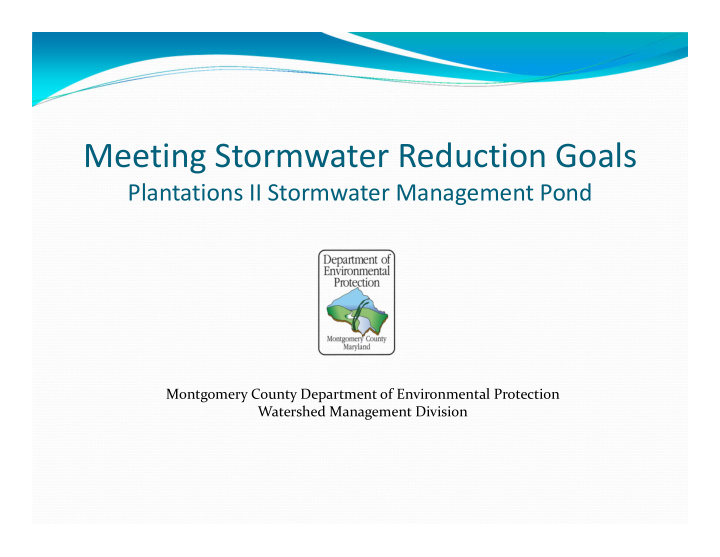



Meeting Stormwater Reduction Goals Plantations II Stormwater Management Pond Montgomery County Department of Environmental Protection Watershed Management Division
Today’s Agenda Sources of Water on Earth Montgomery County background What is a Watershed & Runoff? Intro to Stormwater Plantations II SWM Pond Overview Project Objectives Project Costs and Benefits Design and Permitting Timeline What to Expect During Construction 2
Sources of Water About 97% is salt water About 2% is frozen Only 1% is available for drinking water 95% from groundwater across the Country 32% from groundwater, 68% from surface water in Maryland Potential for greater impacts from runoff in Maryland 3
Montgomery County, MD 500 sq. miles 970,000 people Second only to Baltimore City within Maryland in average people per square mile 184 languages spoken About 12% impervious surface overall About the size of Washington DC Over 1,500 miles of streams Two major river basins: Potomac Patuxent Eight local watersheds District of Columbia Impervious : Not allowing water to soak through the ground. 4
What is a Watershed? A watershed is an area from which the water above and below ground drains to the same place. Different scales of watersheds: Chesapeake Bay Eight local watersheds Neighborhood (to a storm drain) 5
What is Runoff? Water that does not soak into the ground becomes surface runoff. This runoff flows over hard surfaces like rooftops, driveways and parking lots collecting potential contaminants and flows: • Directly into streams • Into storm drain pipes, eventually leading to streams • Into stormwater management facilities, then streams Two Major Issues: Volume/Timing of Runoff Water Quality
What is the County doing to protect our Streams? Must meet regulatory requirements Federal Clean Water Act permit program MS4 = M unicipal S eparate S torm S ewer S ystem Applies to all large and medium Maryland jurisdictions County programs Restore our streams and watersheds Add runoff management Meet water quality protection goals Reduce pollutants getting into our streams Educate and engage all stakeholders Individual actions make a difference Focus on watersheds showing greatest impacts 7
MS4 permit, what is it? Montgomery County is responsible for: • What goes into our storm drain pipes • What comes out of them • What flows into the streams Requires additional stormwater management for 20 percent of impervious surfaces (4,292 acres = 6.7 square miles). That’s about three times the size of Takoma Park. That’s equivalent to 3,307 football fields! 8
Plantations II SWM Pond Damascus, Located on Rolling Plantations II Maryland SWM Pond Magruder Watershed Branch Fork Way near Watershed Woodfield Road (MD ‐ 124) MD 124 Magruder Branch (Great Seneca Creek Watershed) Great Seneca Creek Watershed 9
Plantations II SWM Pond Watershed Area – 88.1 MD 124 Acres Most of the development Rolling Fork Way on Rolling Fork Way 17.50 Impervious Acres Discharges into Magruder Branch Magruder Branch SITE 10
Plantations II SWM Pond Stormwater Management Riser Outlet Structure Wet Pond Pedestrian Path Permanent Pool 20’ high earth embankment dam 7’ deep pool Adjacent pedestrian paths Does not meet all current SWM requirements to achieve MS4 credit. Embankment Dam 11
Project Objectives SWM Maintain permanent pool depth and volume for water quality STREAMS Modify outlet works to better regulate pond discharge and protect Magruder Branch MAINTENANCE Replace existing riser with water ‐ tight structure Install impervious liner on dam embankment Install internal drain in downstream embankment AESTHETICS/ENVIRONMENT Landscape the pond to improve aquatic habitat and aesthetics 12
Project Objectives ‐ SWM SWM Maintain permanent pool depth and volume for water quality 7 feet (at deepest point) Achieve 100% of MS4 water quality requirement 13
Project Objectives ‐ Streams Streams Modify outlet works to better regulate pond discharge and protect Magruder Branch Achieve 100% of MS4 channel protection requirement 14
Project Objectives ‐ Maintenance Maintenance Replace existing riser with water ‐ tight structure Install impervious liner on dam embankment Install internal drain in downstream embankment 15
Project Objectives ‐ Aesthetics Landscape the pond to improve aquatic habitat and aesthetics 16
Project Costs Financial – estimated cost of $300,000 financed through MCDEP CIP Program using funds generated through the Water Quality Protection Charge Recreational – temporary construction impacts to pedestrian path on top of embankment. Forest – tree clearing for to comply with state dam safety laws along the downstream toe of the dam. Neighborhood – construction traffic and noise will typically occur Monday – Friday, 7AM to 4PM 17
Project Benefits Water – improved water quality and stream water temperature through better management of runoff Environmental – reduced downstream discharge allows for natural self ‐ repair of stream channel. Increased aquatic and riparian habitat through landscaping and reforestation. Recreational – increased aesthetic appeal of pond Maintenance – safer operating structure that will require minimal structural maintenance in future. 18
Design and Permitting Timeline Design – July 2013 – February 2014 Approvals – February 2014 Permits – March 2014 Bidding – March 2014 – May 2014 Construction – Summer 2014 19
What to expect during construction Duration Approximately 3 months Construction Hours Monday through Friday, 7AM – 4PM Safety Open sides of site will be fenced with orange construction safety fence Traffic Entrance to site from pedestrian path access at Rolling Fork Way. Minor impacts to traffic from entering and exiting construction traffic and contractor parking during the day. Noise Contractor is required to comply with Montgomery County Noise Ordinance – site elevation will help alleviate noise pollution. Sediment Contractor will be required to comply with Montgomery County Sediment Control Permit and not track dirt onto roads 20
Questions?
Recommend
More recommend